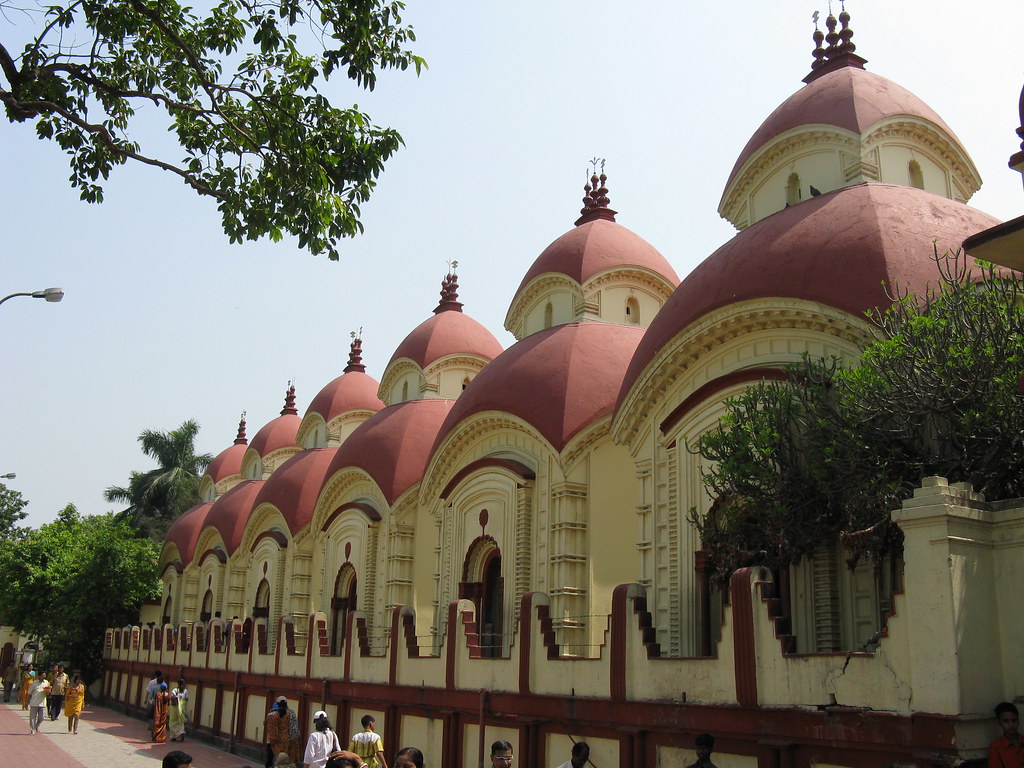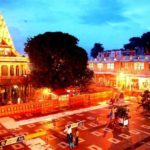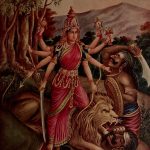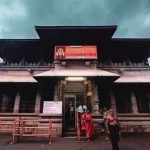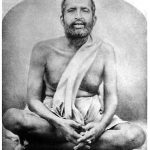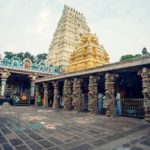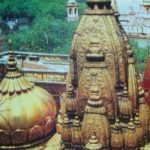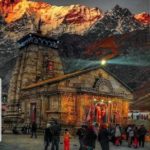This beautiful temple is a must-see for the visitor to Calcutta. It is a temple that is lovely to behold and also interlinked with Bengali history. This beautiful temple is on the banks of the Hooghly river and has Goddess Kali in the Bhavatarini form. The temple and the life of Sri Ramakrishna Paramahansa are closely linked.
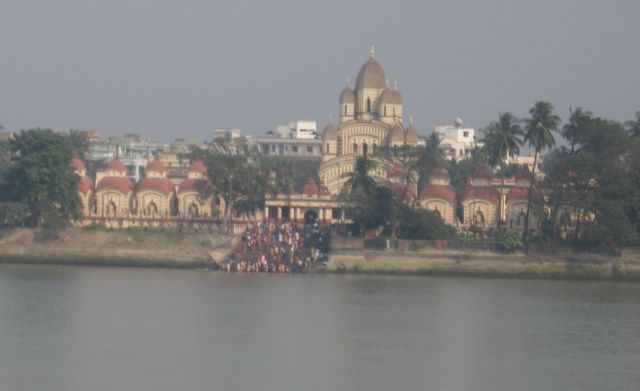
History And Legend
Rani Rashmoni built the temple in 1855. She was a philanthropist. This was a time when the country was under British rule. Barackpur also shared the same river line as the Dakshineshwar temple site. This was where the Sepoy Mutiny Revolt in 1857 started. At that time Kolkatta was the second largest city under the British Empire. The largest was London. A wave of patriotism swept the city. The Rani Rashmoni was also one among those who supported the cause.
The Dream
The Rani Rashmoni was a widow. She was a very capable and able administrator of the huge estate left to her by her husband. Rani Rashmoni was in conflict with British laws as well as policies. She was a very benevolent administrator. The people loved her because of her daring spirit and generosity to public causes. The noteworthy institutions that the Rani Rashmoni supported are the Dakshineswar temple, the bathing ghats, the route from Subarnarekha River to Puri, the Imperial Library (National Library) as well as the Hindu College (Presidency College).
In 1847 she was preparing to visit Kashi to pray to Devi. She was making plans to travel to Kashi by 24 boats. Relatives, servants as well as supplies were to accompany her. However, on the eve of her departure, Goddess Kali appeared to her in a dream. The Goddess then told her that there was no need to go to Kashi/Benares. She instructed her to install her statue on the banks of the Ganges and that she would accept worship there.
Rani Rashmoni immediately looked for a suitable parcel fo land. She then purchased a huge plot in the Dakshineshwar village. It was tortoise shaped and considered suitable for the worship of Devi as per Tantra. The parcel of land was originally partly owned by a Christian and was also partially a Muslim burial ground. The temple complex was then constructed between 1847 to 1855. In the eight years, a sum of nine lakh rupees was spent to build the temple.
Installation
The deity was installed on 31st May 1855 (Snana Yatra day). There was a great celebration and over one lakh Brahmins from around the country graced the occasion. At the time there was a controversy that the Rani was of low birth and did not have the standing to perform the installation and host so many Brahmins. Ramkumar Chattopadhyay suggested resolving the issue by dedicating the temple to a Brahmin. So, it was dedicated to the Guru of the Rani. The installation was a success. The temple was called the Sri Sri Jagadishwari Mahakali Temple. Ramkumar Chattopadhyay was appointed as the head priest of the temple. After a while, his younger brother Gadadhara joined him at the temple.
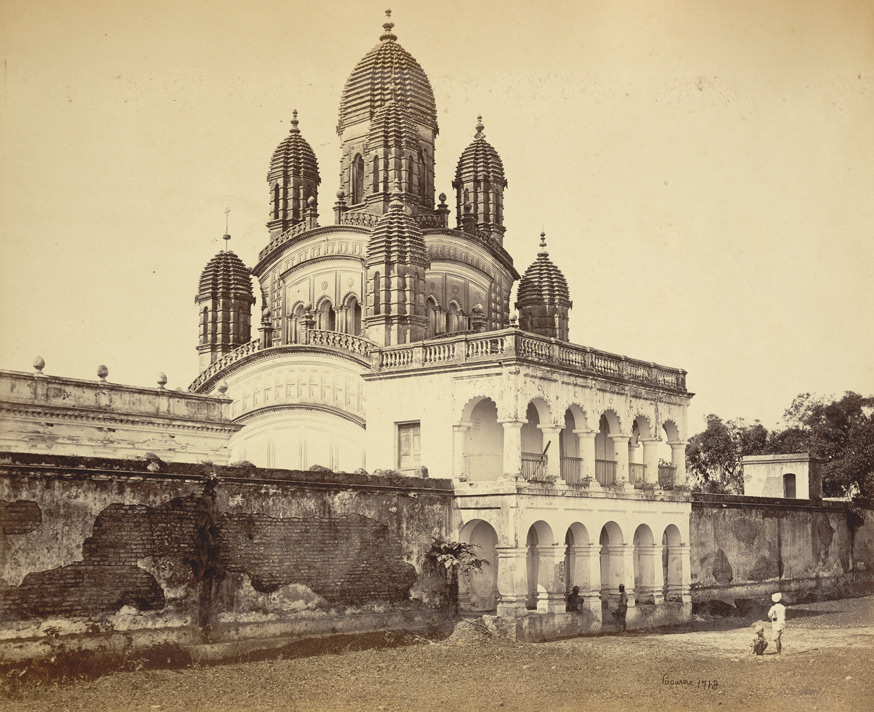
Sri Ramakrishna Paramahansa
Ramkumar passed away in the following year and Gadhadhar and his wife Sarada Devi took over the position. It was Gadhadhar who later came to be known as Ramakrishna who attracted much attention, fame and pilgrims to the temple. Sarada Devi/ Saradamoni lived in a small room on the Southside of the music room and this is now a shrine for her. Sri Ramakrishna started a social change and the Rani also was very open-minded. She wished that people of all castes and religions be able to visit the temple. The temple is still popular among many regardless of their religion and caste.
The Rani Passes Away
Rani Rashmoni died five years and nine months after the installation of the deity. She became very ill in 1961. She made over a property that she had purchased in Dinajpur (Bangladesh) for the maintenance of the temple trust on 18th February 1861 and died the next day.
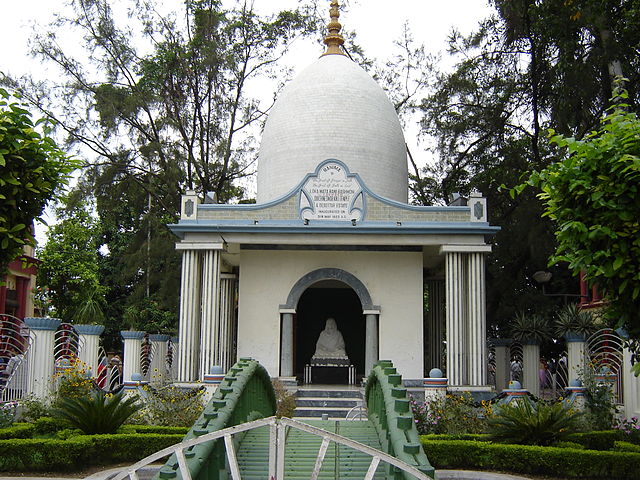
Architecture
The temple is a great example of Bengali architecture. It is built in the Navratna style which alludes to the nine spires. The main temple is three storied and the spires are in the upper two stories. The temple is over 100 feet tall. It has a high platform that is accessed by a staircase. The temple faces south.
There is a row of twelve identical Shiva temples facing the east. They have been constructed in the Aat-Chala Bengali style and are on either side of a ghat on the river. A Vishnu temple called the Radha Kanta Temple is built on the Northeastern side of the main temple. This temple also features a flight of steps. There is a columned verandah with a silver throne bearing the deities. A small shrine dedicated to Rani Rashmoni is at the entrance of the temple complex.
The Deities
Main Temple – Bhavatarini
The main temple is that of Goddess Kali. The sanctum sanctorum has Goddess Kali in the Bhavatarini form standing on Shiva in a supine position. The deities are placed on a thousand-petalled silver lotus throne.
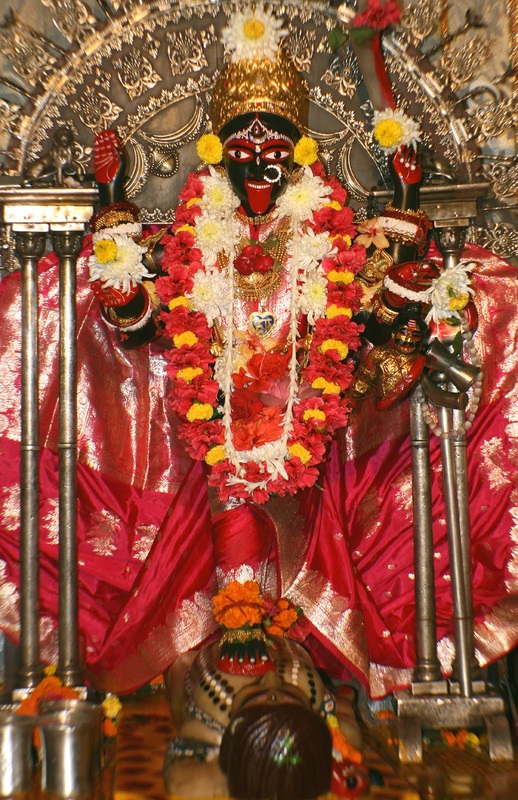
The story of the temple is also the legend of Adyashakti. Once there were two Asura brothers Shumbha and Nishumba. They defeated the Gods and drove them out of heaven. The Gods then sang a hymn in praise of Devi and prayed to her for help. A Devi came out of Adyashakti. She was Kausiki. Adyashakti became dark black in colour and was Kali or Kaliki which means dark.
Another version of the legend states that when Ambika Devi was fighting with the Asura brothers, Devi Kali sprang out of the head of Ambika Devi. She drank all the blood of the Asuras which is why her tongue is out. Devi Kali then went on a rampage of destruction. The Gods feared that she would not stop and therefore called to Lord Shiva for help. Devi Kali did not hear him until he lay in front of her. When she stepped on him she stopped.
The Devi plays with the Mahakal and this is the reason for the name Kali. Goddess Kali is both terrible as well as calm at the same time.
Shiva Temples
The Shiva Temples are 12 identical structures. They are opposite the Kuthi Bari and are close to the river banks, The temples are constructed of black and white stone and house a Shiv Lingam each. The Lingams are Yogeswar, Jatneswar, Jatileswar, Nakuleswar, Nakeswar, Nirjareswar, Nareswar, Nandiswar, Nageswar, Jagadiswar, Jaleswar and Yajneswar. There are six temples to the right and six to the left divided by the river access path or Chandni. Sri Ramakrishna Paramahansa meditated here. Once he realised that the whole word (Jagad) was Shiva (Eshwar) he realised that the whole universe itself was Lord Shiva. He then stopped worshipping the Lingams but would send disciples to the Shiva temples to meditate.
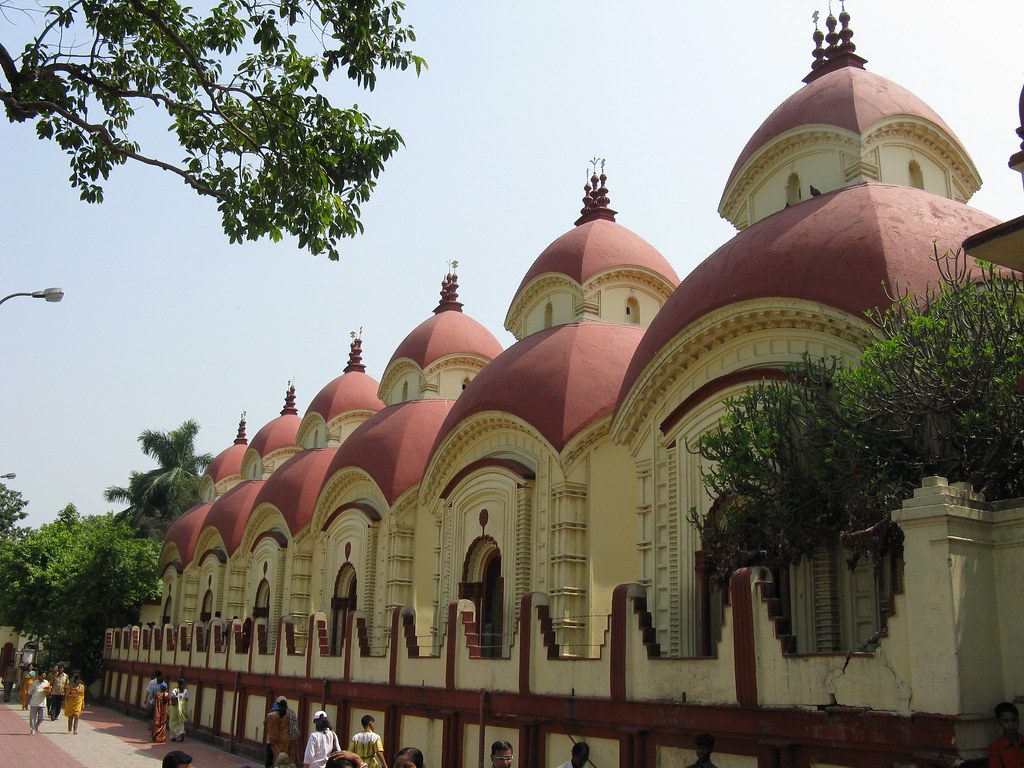
Vishnu Temple
The Radha Kanta temple has a 21 and a half inch idol of Lord Krishna and a 16-inch idol of Radha. Prayers are offered here every day. The original idol of Krishna is placed in the next room. It was replaced when the leg of the idol broke.
Ramakrishna Paramahansa
When Gadadhara was the chief priest of the temple he considered the deity as his own mother. He spent hours with the image neglecting the other duties in the temples. He would go into a trance after spending time with the deity. Ramakrishna described his vision of the mother as an endless shoreless sea of light. The sea was consciousness. He went into trances so often that he was relieved of his priestly duties. He was allowed to remain living on the premises and he continued his spiritual journey here. The temple is now well known for being a part of his journey. He had many disciples who would throng the temple to visit him. He had a very universalist approach. The Rani also wanted the temple to welcome people from all religions and castes.
Travel And Accommodation
The city of Kolkatta is easily accessible by rail, road as well as air. Buses ply from all areas of the city to Dakshineshwar. One can also take a local train that plies between Dankuni and Sealdah. The temple is located 14 kilometres from Sealdah and 10 kilometres from Dankuni. One can also take a train from Howrah Station to the Bali station and proceed from there by bus or train. The temple is 250 metres away from the nearest bus and train stop. There is also a skywalk to access the temple from the station. One can use cycle rickshaws or autorickshaws to travel around the temple area. There is very basic accommodation in the immediate area. A visitor can choose to stay in a more central area of the city and then make a day trip to this temple.
Places Of Interest
Belur Math is another interesting place to visit. It is a boat ride away from the temple. The Math has shrines to Ramkrishna and his wife Saradamoni as well as Swami Vivekananda. One can also see the Panchavati Van or the grove where Sri Ramakrishna used to meditate.




